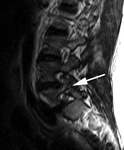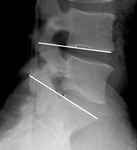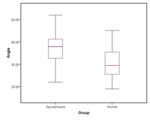Purpose
Spondylolysis is defined as a defect in the pars interarticularis without vertebral slipping [1]. Lumbar spondylolysis is a condition specific to humans due to our unique anatomical characteristic of lumbar lordosis, facilitating upright posture [2]. Clinical features include chronic lower back pain exacerbated by hyperlordosis [3], but spondylolysis may also develop without symptoms [4]. This defect occurs most commonly at L5 and is generally bilateral [5].The precise cause of lumbar spondylolysis is not fully understood. It is thought that repetitive microtrauma and stress fracture is...
Methods and Materials
This is a retrospective case control study. Patients with pars interarticularis fractures demonstrated on MRI (Figure 1) were identified from Radiologists’ databases and from free text searches in RIS. Data was collected from our PACS archive for the years 2002 to 2009. Inclusion criteria included all cases with bilateral L5 pars interarticularis fractures with an accompanying standing lateral radiograph of the lumbar spine. All examinations were reviewed independently by two musculoskeletal consultant radiologists. MR examinations were excluded if there were any abnormalities, other than the...
Results
29 cases with bilateral L5 pars interarticularis fractures which satisfied the study’s inclusion and exclusion criteria were identified. This group contained 16 males and 13 females with median age at diagnosis of 36 years (Range 9 to 63 years).The median interval between the lumbar spine radiographs and the lumbar MRI for the spondylolysis cases was 3 months (Range 0 to 25 months), and 5 months (Range 0 to 38 months) for the control cases.The mean angle of lumbar lordosis measured for the group with bilateral...
Conclusion
The results of this study support an association between lumbar lordosis and spondylolysis at L5, but can not imply causality of the defect.A unifying factor of the mechanical and morphological theories associated with the genesis of spondylolysis is the need for a repetitive motion, such as hyperlordosis, to develop mechanical stress within the pars interarticularis [2,6,13]. It could therefore be argued that an increased lumbar lordosis may increase the risk of developing spondylolysis. Relatively few studies have been carried out to compare the lumbar lordosis...
References
Wiltse LL, Widell, Jackson DW. Fatigue fracture: the basic lesion in isthmic spondylolisthesis. J Bone Joint Surg [Am] 1975;57:17–22.Ward CV, Latimer B. Human evolution and the development of spondylolysis. Spine 2005;16:1808-1814.Jackson DW, Wiltse LL, Dingeman RD, et al. Stress reactions involving the pars interarticularis in young athletes. Am J Sports Med 1981;9:304–12.Fredrickson BE, Baker D, McHolick WJ, et al. The natural history of spondylolysis and spondylolisthesis. J Bone Joint Surg 1984;66:699–707.Cyron BM, Hutton WC, Troup JDG. Spondylolytic fractures. J Bone Joint Surg 1976;58:462-466.Dietrich M, Kurowski...




